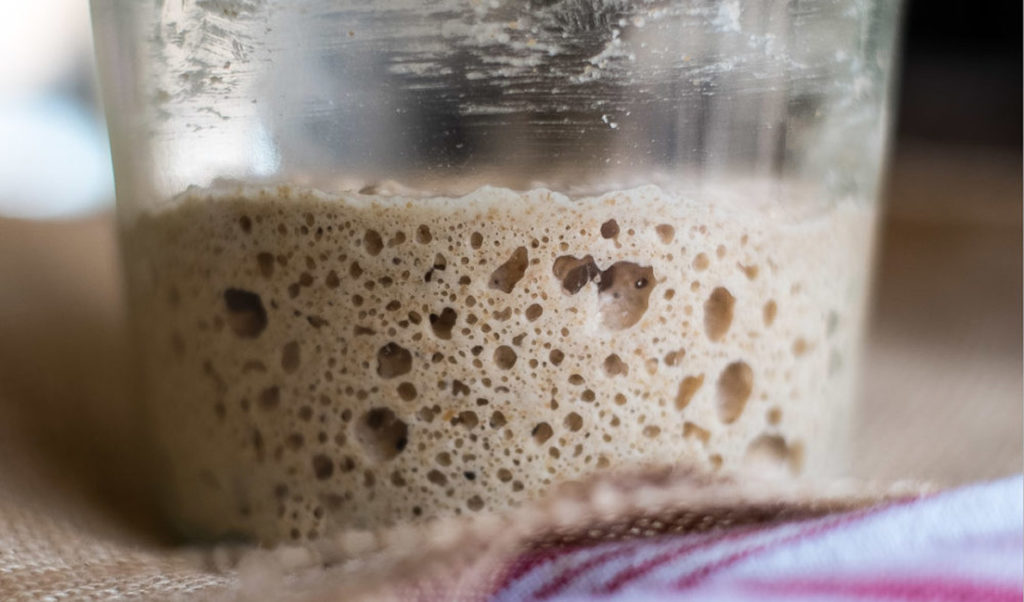Wild Miss Islesford, Barb Fernald’s now-famous and well-traveled sourdough, came to Islesboro last August, when Barb, who lives in Islesford, gave some to me and Courtney Naliboff of North Haven. We all had gathered in Rockland for a panel presentation at the Island Institute and Barb arrived with plastic containers for each of us plus some English muffins she had made out of it.
I took my starter home and put Wild Miss I into the fridge, and toasted up an English muffin. That muffin was a transformative experience. It was simply the best English muffin I had ever eaten. Ever. Better by far than the classic chewy muffins with the big holes that you can get at the grocery store (the only commercial muffins worth acquiring.)
Wild Miss I is wonderfully flavorful and Barb’s method produces incredibly crunchy exteriors when toasted and holes to cradle butter and marmalade. I wrote and asked her for the recipe.
Barb captured Wild Miss I in her home kitchen about a year ago in response to The Sourdough Project at Rob Dunn’s lab at North Carolina State University. Barb says this project is a citizen-science initiative to study the microbiomes in sourdough. People from around the United States, Europe, Australia, New Zealand, and “even one from Thailand,” participated. The project requested samples of their sourdough starters to examine and will eventually analyze them all and let their owners know what microbes are in them and what each has in common (or not) with others. Meanwhile, Barb has shared hers with family and friends and bakes with it.
I’ve messed around with sourdough from time to time, and managed to neglect a couple to death. Remember the Friendship Cake craze of a few decades ago? I had one of those going for a while; I expect it was a form of sourdough, too.
Actually, sourdough is just a very old-fashioned way to capture yeast for baking bread and humans have been doing it for millennia with the very earliest yeasts rising from fermentation, on purpose or not, of grain or fruits.
Keeping yeast has preoccupied us, especially housewives in past times, who harvested yeast from beer brewing until, in America at least, the Temperance movement demonized beer along with rum. Then making yeast depended on previous yeast and the strictest Temperance adherents didn’t want any that came from beer.
Fortunately, a slurry of flour and water left sitting out in a kitchen where no Clorox or anti-bacterial soap or sprays have been employed will be full of applicants for the job of raising bread. Fruit, even dried ones like raisins, has yeasts clinging to them. So, of course, does bread and grain. I’ve often thought that a living room or TV room where fans have been watching a football game would be a terrific place to pick up airborne yeasts let loose from a six-pack or two.
Surely specific flavors characterize predominate wild yeasts of various regions. Think San Francisco’s famous sourdough. I’ll be fascinated to find out from the Sourdough Project just who is lurking in all those samples of yeasts because I’ll bet that my bit of Wild Miss I already has hooked up with Wild Mr. Islesboro, or maybe two or three of Mr. Islesboro’s cousins.
When I made my English muffins following Barb’s instructions, I had flour and bit of dough stuck to bowls and the surface of the table I cut my muffins on, which were sitting out catching goodness-knows-what floating around here. My kitchen is, well, pretty organic, if you catch my meaning. It’s not filthy but it isn’t antiseptic either.
If I set out a bowl of flour and water and gave it a couple of days, I suspect I’d catch a interesting mélange of yeasts to create a sourdough native more or less to this place. If I kept it going and passed it onto subsequent generations, my sourdough would be an ancestor but probably about as different from future batches as I am from my seventh great-grandmother.
I am hopeful that Wild Miss Islesford continues plentifully on in the sourdough I continue to cook with because she sure is tasty stuff. I made two batches of English muffins, and am finally catching on how to manipulate the dough to get the proper thickness and bubbliness for those wonderful nooks and crannies. And for a boule. And a baguette. Wheee.
Sandy Oliver lives, cooks, and writes on Islesboro.





